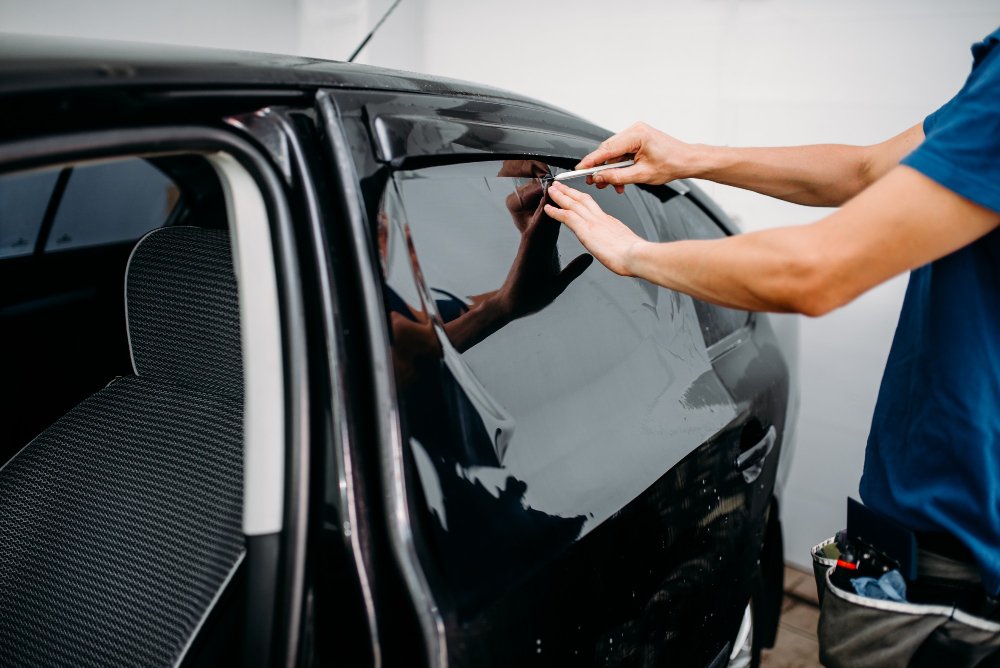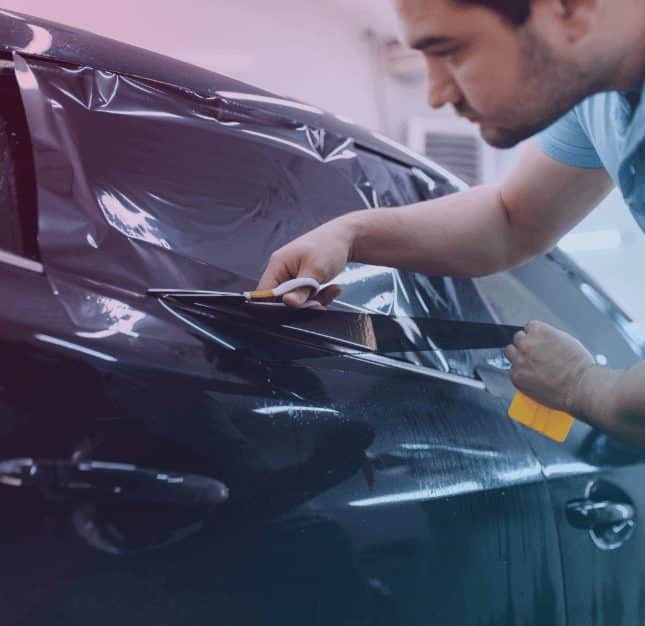Every little thing You Need to Learn About Vehicle Home Window Tinting for Your Vehicle
Auto home window tinting is a sensible enhancement for several lorry proprietors. It provides advantages such as boosted convenience and energy efficiency. Numerous color films cater to different requirements and choices. Understanding legal guidelines and choosing the ideal tint percent is crucial. The setup process and proper upkeep additionally play significant duties in making sure the long life of the color. What other aspects should one consider prior to choosing on window tinting?
Advantages of Auto Home Window Tinting
Some vehicle proprietors might overlook it, vehicle window tinting offers many advantages that enhance both the driving experience and the lorry's longevity. One of the primary advantages is the reduction of warmth accumulation inside the lorry, permitting a more comfortable adventure, specifically throughout warm weather condition. This can lead to decreased reliance on a/c, enhancing fuel efficiency.Additionally, window tinting supplies protection against hazardous UV rays, which can cause skin damage and fade indoor products in time. By blocking these rays, the color helps protect the automobile's inside and keep its resale value.Moreover, tinted windows can improve personal privacy and security, as they make it more difficult for outsiders to see inside the vehicle. This added layer of security can hinder potential burglary. On the whole, car home window tinting acts as a useful financial investment that adds to the automobile and both convenience's overall wellness.
Types of Home Window Color Films
When considering auto home window tinting, automobile owners come across a selection of window color films, each created to meet certain needs and choices. The first category is dyed home window film, which provides a fundamental level of personal privacy and UV defense while being cost-effective. Next, metalized movies integrate tiny metal fragments, mirroring heat and improving resilience, although they may conflict with electronic signals.Ceramic movies are an additional alternative, known for their superior heat being rejected and quality, offering high efficiency without signal interference. Lastly, crossbreed films incorporate qualities of dyed and metalized movies, striking an equilibrium between price and performance. Each sort of window tint movie presents unique advantages, permitting car proprietors to choose based upon their certain demands, such as warmth look, control, and spending plan factors to consider. Recognizing these choices is vital for making an informed decision pertaining to auto window tinting.
Understanding Legal Regulations
When taking into consideration vehicle window tinting, it is vital to recognize the legal laws that regulate color darkness limitations and windscreen color requirements. These regulations can differ substantially from one state to another, impacting what is allowable for vehicle owners. Acquainting oneself with these regulations guarantees conformity and aids avoid possible penalties or penalties.
Color Darkness Limits
Just how can vehicle proprietors ensure they stay compliant with local laws concerning home window tinting? Recognizing tint darkness limitations is crucial. Each state has particular policies that determine the acceptable levels of darkness for window tints, which are gauged by Visible Light Transmission (VLT) percents. Typically, front-side windows need to enable a greater percentage of light contrasted to rear windows. Some states might enable only 30% VLT for front home windows, while the rear home windows could be allowed to have especially darker tints. To ensure conformity, automobile owners need to get in touch with state guidelines or regional law enforcement for accurate info. Furthermore, accredited tinting experts can provide understandings regarding lawful limitations, ensuring that vehicle proprietors make educated choices.
Windscreen Tint Regulations

State-Specific Regulations
Guiding with the landscape of state-specific legislations regarding vehicle home window tinting calls for careful focus to detail, as regulations can vary considerably from one state to one more. Each state has its very own set of rules controling allowed color percentages, kinds of products, and placement on automobile windows. As an example, some states allow darker colors on back home windows while prohibiting them on front home windows, while others have stricter overall limitations. Additionally, specific states mandate the usage of particular materials or call for accreditation from installers. Failure to adhere to these regulations can lead to fines or the requirement to eliminate non-compliant color. Consequently, automobile proprietors ought to consult their state's Division of Motor Autos or relevant authority to assure adherence to local legislations
Selecting the Right Tint Portion
When selecting the right color percentage for a vehicle's home windows, one have to consider various aspects that impact both looks and performance. Tint percentages usually range from 5% to 70%, with reduced percentages providing darker shades and greater portions allowing a lot more light in. A darker tint can improve privacy and decrease glare, while a lighter tint can preserve presence and follow lawful restrictions.Furthermore, individual preference plays a significant duty in this decision. Some people might like the smooth look of darker tints, while others might favor a much more open, airy feeling. Furthermore, the lorry's objective must be considered; for circumstances, those using their lorries for commercial objectives could choose lighter tints to maintain a professional look.Ultimately, the right color percent equilibriums personal design, comfort, and adherence to regional guidelines, ensuring an enjoyable tinting experience.
The Installment Process
An effective installation of home window color needs mindful attention to information and the right devices. The procedure usually begins with comprehensive cleaning of the home windows to remove dirt, dirt, and particles, guaranteeing proper attachment of the movie. Once the surfaces are prepared, the installer measures and cuts the tint film to fit each home window accurately.Next, the movie is positioned on the glass, often making use of a service to facilitate simple adjustment and stop air bubbles. Warmth is in some cases related to the movie to adjust it to the home window's curves, boosting its appearance and durability. After confirming a smooth fit, the installer thoroughly cuts any excess film along the edges.Finally, the installer look for blemishes and confirms all sides are safe and secure. This careful technique is necessary not only for aesthetics yet also for attaining the desired performance advantages of window tinting, such as UV protection and warmth decrease.
Upkeep and Take Care Of Tinted Windows
Appropriate maintenance and care are crucial for protecting the integrity of tinted home windows. Reliable cleaning strategies, the evasion of hazardous chemicals, and routine examinations for damages play important roles in ensuring durability. By complying with these standards, car owners can preserve the practical and aesthetic benefits of their home window tint.
Cleaning Up Strategies for Tint
Keeping the clarity and long life of tinted windows calls for specific cleaning methods tailored to the film's fragile surface. It is important to utilize a soft microfiber cloth to avoid damaging the tint while cleaning. A gentle service of check my blog water and a few decreases of light recipe soap can successfully remove dust and grime. It is advisable to use the cleaning service to the fabric, instead than straight onto the tinted surface, to avoid moisture from permeating into the sides of the film. Mild, round movements need to be utilized to clean the home windows extensively. Regular cleaning aids keep exposure and avoids build-up, making certain that the color continues to be in prime condition gradually. Following these methods will certainly expand the life of colored home windows.
Avoiding Dangerous Chemicals
Although several household cleaning products work on various surface areas, they can present considerable dangers to colored windows. Chemicals such as ammonia, bleach, and particular solvents can deteriorate the color movie, causing discoloration and peeling. People need to choose pH-balanced cleansers especially created for colored home windows. Additionally, using soft microfiber fabrics will help prevent scratches and keep the color's integrity. Normal upkeep is important; as a result, preventing severe scrubbing up or abrasive materials is necessary. It is suggested to read product tags carefully to confirm compatibility with home window tints. By choosing the right cleansing remedies and tools, lorry owners can protect the look and functionality of their tinted windows, assuring a longer life expectancy and optimal performance.
Checking for Damage
Regular assessments of colored windows are essential for identifying any signs of damage that might jeopardize their effectiveness and look. Owners should search for gurgling, peeling, or staining, as these problems can suggest poor installation or exposure to harmful components. It is a good idea to inspect the edges of the movie where peeling off might evaluate and begin for any type of scrapes that could influence visibility. Additionally, ultraviolet (UV) rays can create the tint to deteriorate over time, so checking its efficiency in blocking UV light is essential. If any damages is found, timely action ought to be taken, which might consist of specialist repair service or substitute. Preserving tinted home windows not only enhances aesthetic appeals but additionally guarantees proceeded protection for both travelers and the car inside.
Usual Myths Regarding Home Window Tinting
What mistaken beliefs border home window tinting for vehicles? Several individuals believe that all home window colors are illegal, however laws differ by state, allowing for certain levels of tinting. An additional usual myth is that darker tints block even more warmth; nonetheless, the effectiveness of home window films depends upon their innovation instead than darkness. Some individuals additionally assume that home window tinting is solely for appearances, ignoring its advantages, such as UV security and glare decrease. In addition, many think that window tinting will harm their lorry's glass, yet skillfully applied tints can actually boost glass sturdiness. Ultimately, there is an idea that home window tints block visibility, yet top notch films are created to keep clear sightlines while offering privacy. Recognizing these misconceptions aids customers make informed choices concerning internet window tinting, guaranteeing they take pleasure in the full variety of advantages it uses.
Often Asked Questions
For How Long Does Window Tinting Typically Last?
The longevity of window tinting differs based upon factors such as installment high quality, movie type, and environmental problems. Usually, high-quality tint can last anywhere from five to 10 years prior to requiring substitute or reapplication.
Can I Eliminate Home Window Tint Myself?
Removing window color oneself is feasible, though it may be challenging. Individuals need to utilize a warmth source and glue eliminator to alleviate the process, but care is suggested to avoid harming the automobile's glass or inside.
What Devices Are Needed for DIY Home Window Tinting?

Will Home Window Tinting Damages My Auto's Glass?
Home window tinting, when used properly, normally does not harm a vehicle's glass. Improper installment or low-grade films might lead to peeling off, bubbling, or scratching, possibly endangering the integrity of the glass over time.
Can Tinted Windows Impact My Lorry's Resale Value?
The influence of colored home windows on a vehicle's resale worth can vary. While some customers value the added privacy and UV security, others might see it as a prospective concern, potentially influencing resale favorably or adversely. When considering vehicle window tinting, lorry proprietors experience Your Domain Name a range of home window color films, each created to meet specific requirements and preferences. When taking into consideration car window tinting, it is crucial to understand the lawful policies that govern color darkness limitations and windscreen tint needs. Normally, front-side home windows have to permit a higher portion of light compared to rear home windows. Some states might permit just 30% VLT for front windows, while the rear home windows could be permitted to have notably darker tints. Some states permit darker colors on back windows while banning them on front home windows, while others have more stringent general limits.